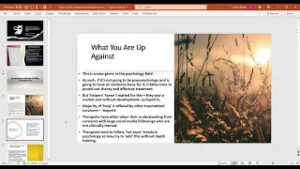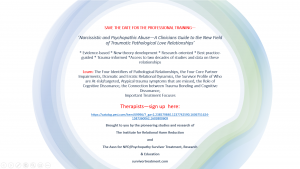Psycho girlfriends. Toxic boyfriends. The pathological relationship. We’ve all heard about it or experienced it for ourselves. Even if we’re not familiar with its various names or the psychological explanations behind it, we’re not surprised when we hear that a friend or family member is in a physically or emotionally abusive relationship. Whether it’s a girl insulted and humiliated by her boyfriend, or a man whose wife leaves him, takes his money, their kids, and his reputation after a painful divorce, these pathological relationships still seem to be a natural part of our daily experience. The pain and hopeless cycles of these relationships remind us that pathology in relationships is all too common.
Luckily there is a growing body of research on these all-too-familiar dynamics, and therapists trained in dealing with them. Sandra L. Brown, M.A.’s How To Spot a Dangerous Man and Women Who Love Psychopaths; Martha Stout’s The Myth of Sanity and The Sociopath Next Door; and Robin Stern’s The Gaslight Effect. These and other essential materials bring an important body of knowledge to those who need it most. Because without such knowledge, we are like Goldilocks entering a dark and unknown forest, blind to the dangers of charming yet cunning predators.
Upon meeting and interacting with such a predator, many men and women ignore the warning signs, rationalizing the odd behavior that doesn’t quite add up. Unfortunately, that inability to recognize the warning signs—the ever-so-slight intuition that something is wrong—is the first step in a downward spiral of deceitfulness, manipulation, and suffering. And unfortunately, a clever psychopath is an expert at taking advantage of this gap in our knowledge. Like a hyena picking out the weakest of the herd, they spot our weaknesses and exploit them ruthlessly.
The purpose of the materials listed above, and this magazine, is twofold. On the one hand, the information helps to educate those of us who have not been in a pathological relationship. By learning the signs, we can avoid such a relationship before it happens. On the other hand, it provides the information necessary to help those of us within such a relationship to recognize what is really going on, and that there is a solution.
The simple act of learning that one’s partner, or parent, or sibling, is pathological can be therapeutic in itself. Then we know that we’re not crazy—there is an explanation for their incomprehensible and often inconceivable behavior, and there are others who have gone through the exact same thing. Simply learning that language brings relief, comfort, and the strength to continue healing.
But let’s step back for a moment here and look at the bigger picture. Surely the partners of these individuals are not the only ones affected by their pathology. They have jobs, and because of their own ruthless drive for power and control, they often achieve influential positions in corporations, churches, and politics.
The purpose of this column is to analyze the pathological “dictators” in our lives, both on the interpersonal level—the dirty tricks and subtle manipulations we encounter in our everyday interactions—and on the wider, societal/political level—from our bosses, political leaders, and church authorities. We know the havoc one psychopath can bring down upon just one individual. When in a position of great power and influence, that havoc is vastly increased, as their pathology affects the lives of entire nations.
Just as the books listed above are essential tools in bringing an understanding of the pathological relationship to the general population, several recently published books expand this approach to the broader, social dynamics I’ll be exploring in this column. They have all influenced me greatly, and I’ll refer to them frequently. They are Andrew Lobaczewski’s Political Ponerology; Martha Stout’s The Paranoia Switch; and Paul Babiak and Robert Hare’s Snakes in Suits. Their work provides a solid foundation for understanding how the pathological relationship applies to every facet of our lives.
In this column I will not only analyze historical and contemporary examples of such pathology in high places, but also the similarities between the interpersonal dynamics and the sociopolitical dynamics. Whether in your own home or in the Whitehouse, pathological individuals use the same tricks. And, luckily, when their tricks are revealed, when they’re exposed for the petty tyrants they really are, they’re powerless.






